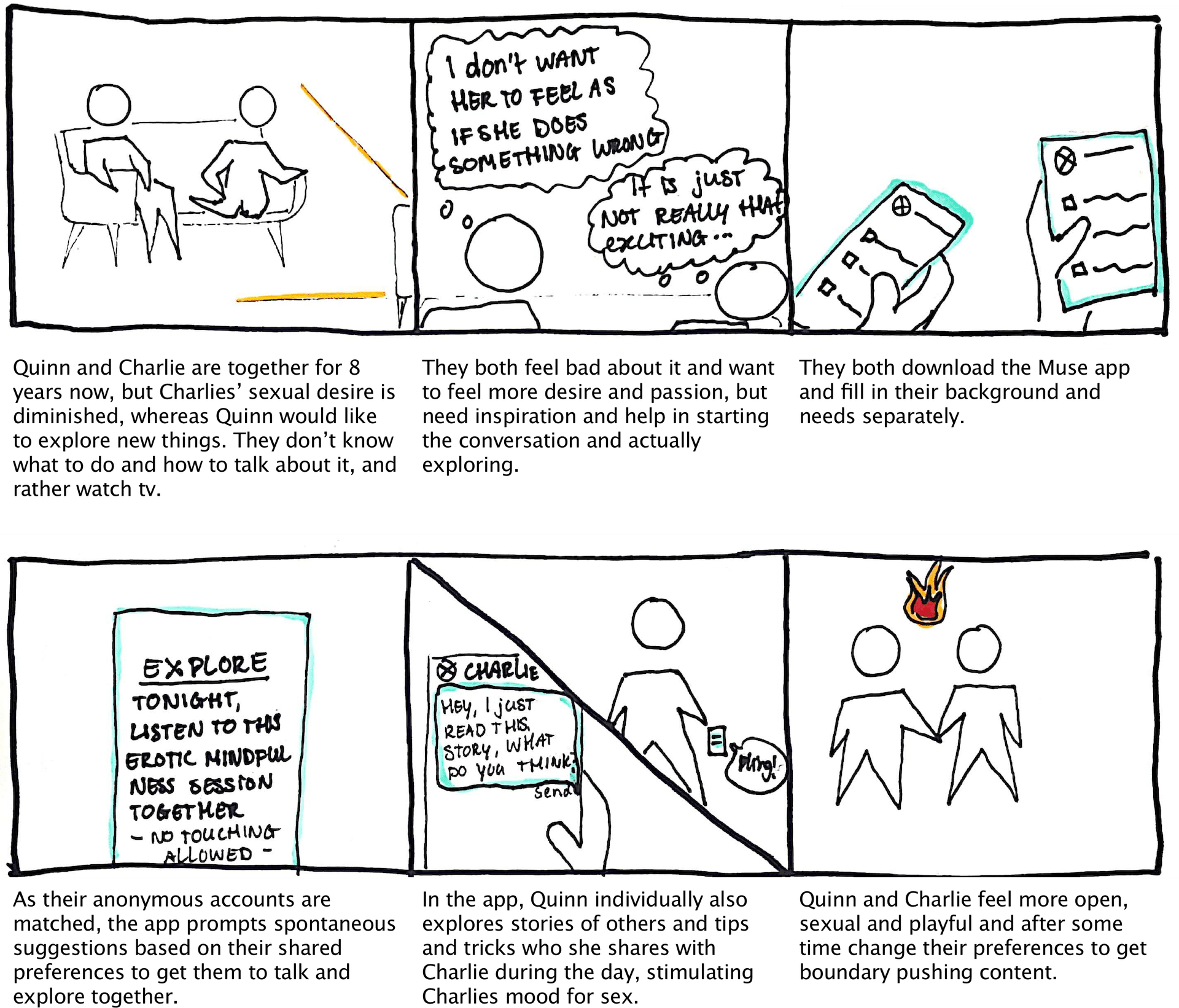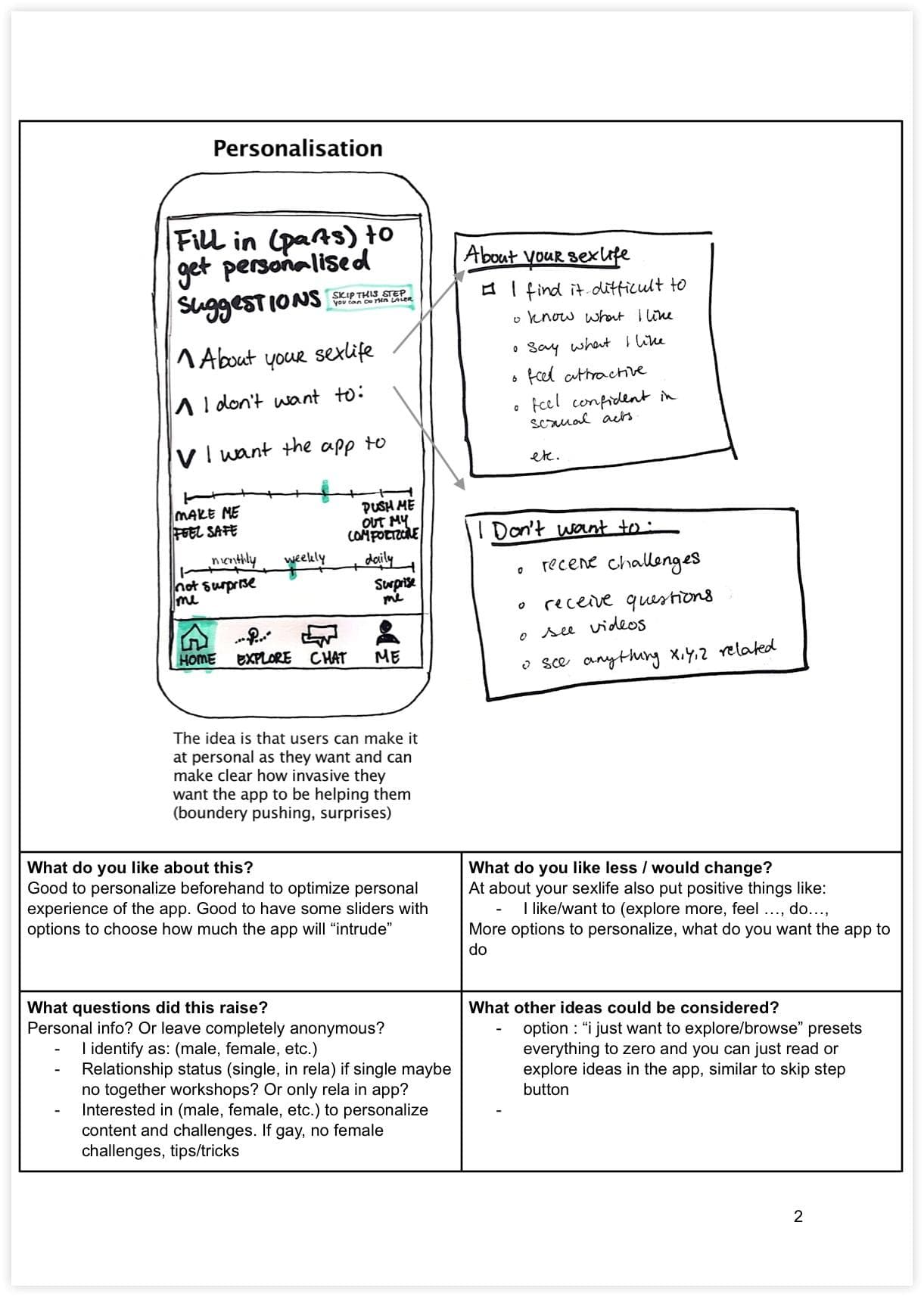Couples (especially millennials) are experiencing low sexual desire and activity, and I wanted to investigate why this is and how technology could be of support. Through conducting a survey and participatory design sessions, I created a low-fidelity prototype of a conceptual solution: Muse, an app that provides inspiration and suggestions based on preferences and background information, and spontaneously prompts users with questions, adventures, and tips and tricks. *I conducted this project as part of my dissertation when studying HCI at UCL, which was awarded with a distinction.
Team
Individual university project under supervision Dr. Aneesha Singh and PhD. Dilisha Patel.
My Role
Conducting primary and secondary research, exploring ideas through participatory design sessions, creating low-fidelity prototypes and reviewing.
Timeline
June 2020 - Sept 2020 (3 months)
The problem
Compared to earlier generations, the sexual desire and activity of cohabiting millennials (born between 1981 and 1996) have shown a significant decline while their wish to engage in sex has increased. Lower levels of sexual desire can lead to lower relationship satisfaction and more depressive symptoms, which millennials already report to experience. It is therefore important to stimulate sexual desire. The ubiquitous presence of technology seems to undermine millennials’ desire, but recent developments in the industry and HCI research also illustrate the potential of technology in facilitating sexuality. However, no research has yet explored how technology can support sexual desire, and be an enabler rather than a barrier.
Challenge
To investigate how technology can kindle sexual desire, I wanted to:
- Understand the challenges, needs and current practices of cohabiting millennials in maintaining sexual desire. This research was conducted during the outbreak of COVID-19, which has shown to change sexual activity both positively and negatively. Therefore, attention was paid to the impact of the pandemic on participants’ sex life to avoid biased insights and better understand impacting factors.
- Translate these needs into a low-fidelity prototype of a conceptual design solution.
- Evaluate this low-fidelity prototype to deepen user requirements and provide suggestions for further research and design iterations.

Phase one: understanding needs
First, I conducted a literature review to learn about existing issues in sexual desire, and existing technologies supporting sexuality. To verify these findings with the user group and to further understand the characteristics and difficulties of millennials’ sexual desire, their technology use and needs in a future product, I designed and conducted a web-based anonymous survey among 77 cohabiting millennials. This method enables more self-disclosure of sexual information, and helped me to be time efficient and recruit participants for follow-up research.

In closed questions, I asked about the status of participants’ desire, and psycho-sociological factors impacting sexual desire (such as attraction, self-esteem, communication, attitudes, and motivation). Open questions considered the impact of COVID-19 on millennials’ sexual desire, behaviours in maintaining sexual desire, experience in the use of products that increased their desire, and needs in future technology that enhances desire.
Based on the results, I established initial design requirements. The product should:
- Be discrete, compact, un-invasive
- Not attract the attention of each other
- Have no long explanations, stories or texts
- Protect data and privacy (no relation to big companies like Google)
- Be personalisable and not dictate what is correct use, or refer to things users may have negative associations with
- Not put pressure on partner/self
Through a cluster- and correlation analysis of the survey data, I extracted 5 data-driven personas from the survey data. Using descriptive statistics of quantitative data and content analysis of qualitative data, I reported the data per persona.

Phase two: further exploring needs, and solutions
I then conducted eight 1.5 hour one-on-one online participatory design sessions using the survey-data driven personas to get a more in-depth understanding of participants’ needs, and explore possible design solutions. I chose this a participatory approach because sexual desire is complex and highly subjected to personal culture, values and behaviours. It exists in a difficult to observe private context, challenging the standard user-centred design process, so first-hand data on lived experiences, explorations, and discussions with millennials were needed to understand what and how things influence their sexual desire. I aimed to conduct the sessions with multiple participants, but participants preferred one-on-one sessions.
I screened participants on their sexe and level of satisfaction and activity in feeling sexual desire (asked in the survey) to ensure a range of types of participants were included. This enabled me to understand both the problems experienced by dissatisfied participants as well as solutions/successful practices used by satisfied participants. There were no people identifying as LGBTQ interested in participating in study 2 and 3, which limited the range.
During the sessions, I decided to use the identified requirements and data-driven personas as a skeleton to ideate solutions from. This supported design decisions and helped ensure that solutions fitted the needs of this whole user group, not only from the design session participants. Participants mentioned that these personas helped them to talk and share their difficulties in sexual desire more easily, and that it helped them come up with ideas.
I first asked participants to pick two persona’s they found most interesting and then asked them about their relationship, challenges and opportunities in sexual desire and needs in a future product. This flowed into an ideation session on a collaborative online whiteboard where I sketched solutions together with the participants.

To simulate a participatory design session with multiple participants, I then asked the participant to review anonymised sketches of the other participants, where I asked them what they found to be most helpful, challenging and undesirable in all the ideas discussed.
I recorded the participatory design sessions and analysed them using bottom-up thematic analysis. When I had gathered all the data, I used the initial codes to form (sub)categories and themes using affinity diagramming. I focussed on problems and related ideas and solutions participants had discussed.

Findings showed that cohabiting millennials struggle most with spending time and effort to create this space for sexual desire, while many felt the need to increase sexual desire. This was found to be related to distractions of their busy lifestyle and technology, stress, habituality, and shame, but also related to conflicting views on sexual desire (should work on desire vs. should occur spontaneously) and a lack of suitable resources to explore sexual desire, leading to less inspiration. These new insights led to additional requirements, which supplemented the requirements extracted from the survey data. I then prioritised the requirements based on participants’ needs I identified earlier.

The (most mentioned) ideas they sketched were apps that helped them create new experiences, supported uniqueness and fluctuations in sexual desire through personalisation, supported desire-related shame and trust, and helped to set boundaries of intimate vs. daily life. As participants had reviewed each others’ sketches, I was able to prioritise ideas and features they found most useful and merge them into one conceptual design: Muse.
Muse
The idea of the app ’Muse’ is that it provides inspiration and suggestions based on preferences and background information, and spontaneously prompts users with questions, adventures and tips and tricks (for the individual or the couple - when accounts are paired), depending on their settings.

Phase three: validating the concept
In the third study, I focussed on validating the concept and further exploring needs through getting the opinion of 11 millennials on this concept in evaluations. I wanted to know whether the concept would be received differently by new participants without prior involvement in the study, in order to elicit additional needs and verify the fit of this solution for this user group. Unfortunately, I had no time to conduct many new interviews. Therefore, I decided to conduct four 20-min online semi-structured experience-interviews with new participations, and ask the participants of the participatory design sessions (7 agreed) to autonomously evaluate the conceptual design, as they already knew the study and ideas from others. I created a storyboard to provide context of use, and separate documents where questions were asked under each sketch with explanation. Participants were asked questions such as: What are your thoughts on the usefulness of this idea to enhance desire? What do you like about it? What would you change/remove/improve/add? What questions did it raise? What other ideas could be considered?

Participants showed great enthusiasm for the concept in creating space for and building sexual desire and provided additional and promising insights on the design. In particular, they emphasised the technology’s ability to offer personalisation, surprises/spontaneous prompts, multi-modal content and privacy protection.

Outcomes and learnings
- The chosen methodology (using anonymous surveys, one-on-one participatory design sessions and personas) worked really well in gathering relevant data. With this, I hope to make it easier for people to research this topic, as it is a core element of life and important to understand humans, which is essential in HCI and could drive innovation. Conducting the research remotely seemed to make it easier to recruit participants, and talk about sex more easily. However, designing remotely with people who have no experience in design or technology was sometimes difficult. Next time, I would provide building blocks (UI elements, a library of shapes and patterns) so they can create something more easily.
- The need for some features really depended on how well they could be personalised (e.g. balance in boundary-pushing vs. safe content) so in following iterations I would explore and test different approaches, involving users and sex-experts.
- I would like to further develop the concept into a high fidelity prototype through multiple iterations of design and usertesting. Then I would conduct a longitudinal study, a diary study, to see if, and how, the concept actually positively impacts millennials couples’ sexual desire.
- This project was part of my dissertation, which was awarded with a distinction. It offers novel design recommendations that help to understand how to design for sexual desire and which interactions are most important (e.g. helping to create new experiences, supporting uniqueness and fluctuations in sexual desire etc.). With this, I hope to motivate designers to use these insights when creating new products.
